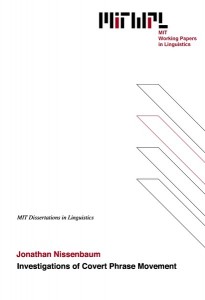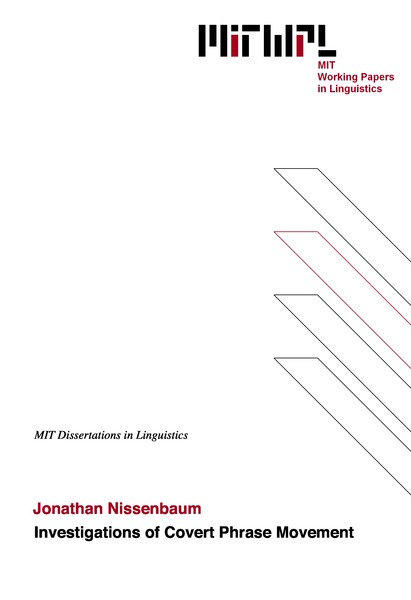Investigations of Covert Phrase Movement
J. W. Nissenbaum, 2000
The status of covert movement in Universal Grammar has been a perennial source of trouble in the study of language. What kinds of structures does it derive? To what extent is it similar to overt movement? What is its place in the overall architecture of the grammar?
In this thesis I present several case studies bearing on these questions, providing new evidence for the existence of covert phrase movement. These studies contribute to the growing body of evidence that grammatical conditions hold only at interface levels (Chomsky 1993). Further, I attempt to show that, taken together, the investigations reported here lead to a model of grammar in which the interface representations are computed cyclically, by successive applications of the basic grammatical operations merge, move and spellout on each phase of derivation.
The first studies demonstrate that covert movement licenses parasitic gaps and feeds Condition A, reversing longstanding assumptions. The apparent counterevidence that has obscured these properties of covert movement, I argue, results from a general constraint on movement (the Tucking-in condition (Richards 1997)) that prevents the formation of the required configurations in the classic experimental paradigms. In addition, the study on parasitic gaps provides evidence for the Y-model’s sequencing of overt before covert operations. However, an investigation of adjunct extraposition from NP (a report of joint work with D. Fox) yields evidence for the opposite conclusion: that a covert operation (QR) can be followed by an overt one (late adjunction to the raised NP)
Finally, I show that these conflicting results are resolved by a theory of successive-cyclic computation of structure in which spellout applies repeatedly throughout a derivation. I argue that the correct characterization of the cyclic model captures Y-model effects such as the failure of covert movement (typically) to license PGs, while allowing ‘anti-Y-model effects’ typified by extraposition. I propose a condition that limits countercyclic adjunction to the linear edge of already computed structures. This condition in turn predicts an intricate pattern of further generalizations about extraposition. The resulting theory thus unifies the overt and covert cycles in a manner consistent with the evidence for covert phrase movement.
Thesis supervisor: Noam Chomsky, David Pesetsky
Title: Institute Professor, Ferrari P. Ward Professor
Table of Contents
Chapter 1 Introduction 11
1 Evidence for a vP-peripheral landing site in successive-cyclic
movement 14
2 ‘Y-model effects’ and ‘anti-Y-model effects’ 16
2.1 Covert movement and PGs: a ‘Y-model effect’ 16
2.2 Support for the picture: covert movement and Condition A 19
2.3 Covert movement and extraposition from NP: an ‘anti-Y-
model effect’ 21
3 Cyclic spellout: covert movement in a single-cycle grammar 22
Part One On the structure of LF representations 28
Chapter 2 What Parasitic Gaps can tell us about the hidden structure of
chains 29
1 Background: the syntactic properties of parasitic gaps 30
1.1 Two kinds of theories 34
1.2 Arguments for the Null Operator hypothesis 38
1.3 Right-branching vs. adjunction to vP 45
1.4 Summary 51
2 Why PGs exist in natural language 52
2.1 A proposal: HNPS and vP-adjoined predicate modifiers 55
·‘Long-distance’ HNPS 59
2.2 Generalizing the proposal: successive-cyclic movement
through spec-vP 64
·Independent support for the vP-step 67
3 The utility of PGs as a diagnostic for invisible structure 71
3.1 Larson’s generalization: HNPS past the adjunct makes PGs
obligatory 73
3.2 A predicted correlation: PGs and the positions of
intermediate traces 78
3.2.1 Stacked vP-adjuncts 80
3.2.2 Extraposition from wh 85
3.2.3 Antecedent-contained deletion 86
4 Summary of main results 94
Appendix Subject PGs 96
1 Parasitic arguments and the semantics of modification 99
2 Evidence that parasitic subjects always reconstruct 107
Part Two Case studies on the computation of LF representations 112
Chapter 3 An apparent ‘Y-model effect’: covert movement and parasitic gaps 113
1 Deriving Engdahl’s generalization 117
1.1 Bulgarian multiple-wh-questions and the Tucking-In
condition 118
1.2 Tucking in explains why covert movements don’t (normall)
license PGs 120
2 Predicting the cases where Engdahl’s generalization fails to hold 122
2.1 A Bulgarian word order puzzle, and a simple solution 122
2.2 A ‘Bulgarian strategy’ for multiple PGs in English 123
2.3 Properties of PGs that are licensed by covert movement 128
·A predicted asymmetry with single PGs 128
·Order of the PGs is determined by order of licensing
movements 128
·Both PGs must be in the same island 129
·Evidence for pied-piping in covert movement 130
3 Multiple overt extractions in English and multiple PGs 131
3.1 HNPS coupled with wh-movement licenses two PGs 131
3.2 Pesetsky’s Volvo-sentences 132
4 QR and parasitic gaps 136
4.1 Tucking in and the scope economy condition 138
4.2 Subjects and stacked vP-adjuncts 140
5 Conclusions 141
Appendix Covert movement and Condition A 143
1 Why the old paradigm is uninformative: the TIC 144
2 A more informative paradigm 145
3 Covert movement feeds Condition A 145
4 Further support 146
·Movement that feeds Condition A is incompatible with idiomatic
readings 146
·Movement that feeds Condition A forces wide scope for how-
many-NP 147
·Movement that feeds Condition A forces wide scope in a ‘Baker’
sentence 148
5 Summary 148
Chapter 4 An apparent ‘anti-Y-model effect’: covert movement and
extraposition from NP 149
1 Extraposition from NP: a puzzle 151
2 The proposal – post-QR merger of adjuncts 151
3 Prediction for scope 154
4 Complements vs. adjuncts – further predictions 156
5 Testing whether the extraposed constituent moves 158
5.1 Definiteness 158
5.2 Condition C 159
5.3 Coordination 160
5.4 Parasitic gaps 161
6 Testing whether the source NP undergoes QR 161
6.1 Scope of the source NP 162
6.2 QR in co-ordination 163
7 Conclusions 165
Appendix covert movement and ‘hidden PGs’: extraposition past elliptical
adjuncts 167
Part Three Resolving the contradiction 172
Chapter 5 Syntax and the single cycle: on the nature of covert movement and
the architecture of grammar 173
1 Preliminaries: the cycle 177
1.1 Successive-cyclic movement 182
2 Toward a cyclic theory of spellout 186
2.1 Spellout applies to the internal domain 187
2.2 Parameterization: a cross-linguistic typology of wh-fronting 191
2.3 ‘Spellout of internal domain’ yields Phase Impenetrability
effects 194
3 Y-model effects and anti-Y-model effects 196
3.1 No merge during the post-spellout portion of a phase 199
3.2 Post-cyclic merge and the Linear Edge Condition 201
3.3 Preliminary evidence: the Linear Edge Condition and
word-formation 203
3.4 Summary 206
4 Further evidence for the Linear Edge Condition 207
4.1 Only right-most constituents in DP can be extraposed 208
4.2 Extraposed adjuncts must appear rightmost in the vP 209
4.2.1 No adjunct extraposition to the left of a HNPS 210
·Complement extraposition is different 211
4.2.2 No multiple extraposition to the same vP-domain 211
·Complement clauses allow multiple extraposition 213
·Multiple adjunct extraposition to different vPs 213
4.2.3 No extraposition to the left of (cyclically merged)
vP adjuncts 215
·Complement extraposition to the left of a parasitic
adjunct 217
4.3 Extraposition in wh-movement environments 218
4.3.1 When Tucking-in is violable 220
4.4 Summary 221
5 Some possible extensions: on the absence of wh-islands for covert
movement 223
5.1 Raising out of an embedded question: the ‘Baker-
ambiguity’ 224
5.2 How is attraction of a ‘tucked in’ wh-phrase possible 226
5.3 Wh-islands reduce to violations of the wh-spellout
parameter 228
5.4 Predicting a cross-linguistic distribution distribution of
wh-island effects 229
5.5 Path Containment Condition effects 232
6 Summary and conclusions 234

